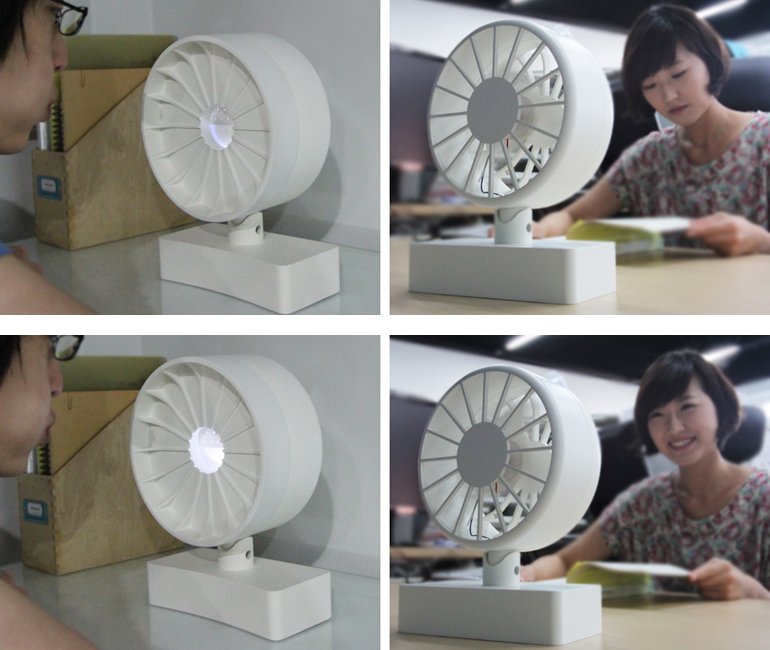cixd creative interaction design lab.
Altruistic Interaction Design

The importance of design ethics in HCI has gained increasing attention the last several years. In this research, we propose a new concept of interaction that restructures its conventional notion. It is expected that this new concept will increase social empathy among people, which will eventually result in more positive ethical behaviors. This new structure of interaction breaks the current closed interaction cycle that focuses on a complete input-output feedback loop. Instead, it makes the cycle imperfect so that people cannot experience it without seeking help from others or being helped by the same. We call this concept altruistic interaction design and designed a case, the Altruistic Fan, as an applied product example. This paper explains the concept of altruistic interaction design and its application process to a real product. The study closes with the results of an exploratory user study utilizing an altruistic interaction design product (Altruistic Fan).
-
Your Smartphone Can Be Well-Mannered: Five Ideas to Improve Smartphone Manners
Lee, Y. and Lim, Y., “Your Smartphone Can Be Well-Mannered: Five Ideas to Improve Smartphone Manners,” Proceedings of IASDR’13 (International Association of Societies of Design Research), Tokyo, Japan, August 26-30.Abstract
Despite the numerous advantages of the smartphone, bad manners have become a topic of increased discussion. In this research, we found actual cases of bad manners regarding smartphone usage and investigated the causes of this behavior. We collected 30 Asian participants’ episodes of their bad-manner experience of smartphone use through an online-survey. The causes of cases could be grouped into the following categories: 1) Low social acceptability in a specific place, 2) Lack of signifiers of user’s behaviors, 3) Misjudgment of the identity of the user by unintentional releasing private information, 4) Mistakes due to unfamiliar interface and technology, and 5) Stereotypes of smartphones toward disconnection concerns. Based on insights, we suggest new concepts for more courteous smartphone usage. These concepts help to bridge the gap between the new and the traditional to enhance the social acceptability of smartphones, allowing the smartphone to provide users with signifiers by extending and displaying status, enabling the user to implement a digital persona and digital ego to prevent misjudgment, and broadcast the user’s status from the physical world to the virtual world to resolve disconnection concerns. We propose these concepts to introduce design possibilities for future smartphones in our sophisticated social contexts.
-
Altruistic Interaction Design: A New Interaction Design Approach for Making People Care More about Others
Lee, Y., Lim, Y., and Suk, H. “Altruistic Interaction Design: A New Interaction Design Approach for Making People Care More about Others”, Proceedings of Conference on DPPI ’11 (Designing Pleasurable Products and Interfaces), ACM Press, Milan, Italy, June 22-25, pp. 59-62.Abstract
The importance of design ethics in HCI has gained increasing attention the last several years. In this research, we propose a new concept of interaction that restructures its conventional notion. It is expected that this new concept will increase social empathy among people, which will eventually result in more positive ethical behaviors. This new structure of interaction breaks the current closed interaction cycle that focuses on a complete input-output feedback loop. Instead, it makes the cycle imperfect so that people cannot experience it without seeking help from others or being helped by the same. We call this concept altruistic interaction design and designed a case, the Altruistic Fan, as an applied product example. This paper explains the concept of altruistic interaction design and its application process to a real product. The study closes with the results of an exploratory user study utilizing an altruistic interaction design product (Altruistic Fan).
Video
-
What a Polite Robot!: Applying Politeness Strategies to Speech Interface of Robotic Product
Bae, J., Lee, Y., and Kim, M. “What a Polite Robot!: Applying Politeness Strategies to Speech Interface of Robotic Product”, DIS’12 (Designing Interactive Systems) Poster. Newcastle, UK, June 11-15Abstract
We applied politeness strategies to formulate conversation via expressions by a robot vacuum cleaner to enhance the user’s evaluation of the robot. We delivered to users three versions of such a robot which differed in terms of their politeness strategy, as follows: 1) positive politeness, 2) negative politeness and 3) no politeness strategy. The evaluations of the robot’s functionality, character and satisfaction of use concluded that the robots employing politeness strategies were better accepted by users. The robots with politeness strategies were felt to be more considerate, polite, familiar, and fun to use. The results suggest that users regard robots as social companions when politeness strategies are applied to the robots.
Video